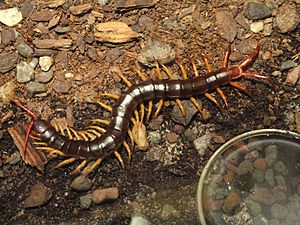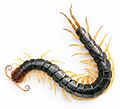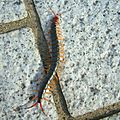Scolopendra subspinipes facts for kids
Quick facts for kids Scolopendra subspinipes |
|
|---|---|
 |
|
| Scientific classification | |
| Genus: |
Scolopendra
|
| Species: |
subspinipes
|
| Synonyms | |
|
Rhombocephalus smaragdinus |
|
The Scolopendra subspinipes is a very large centipede that lives in many parts of the world, especially in eastern Asia. It's one of the most common types of Scolopendra centipedes. You can find it around the Indian Ocean, in tropical and subtropical Asia (from Russia to Malaysia and Indonesia), Australia, South and Central America, and the Caribbean islands. Scientists aren't sure how much of this spread is natural or if humans helped move them around.
This centipede has many common names because it lives in so many places and has different colors. Some names include Chinese red-headed centipede, jungle centipede, orange-legged centipede, red-headed centipede, and Vietnamese centipede. It can grow up to 20 cm long, which is about the length of a pencil. This centipede is an active and aggressive hunter. It will try to catch and eat almost any animal it can overpower.
Contents
What Does It Look Like?
This centipede is quite large, growing up to 20 cm long. Its body is usually red or reddish-brown. Its legs are often yellow or yellow-orange. Like other centipedes in the Scolopendra family, it has 22 body segments. Each segment has one pair of legs.
At its head, it has a pair of special legs called forcipules. These are covered by a flat shield. The forcipules have sharp claws that connect to venom glands. They are the main tools the centipede uses to catch prey or defend itself. Centipedes breathe through small openings called spiracles. These openings are found along the sides of their bodies. They can be round or S-shaped. These centipedes have simple eyes and don't see very well. Instead, they rely on touch and their chemoreceptors to sense their surroundings.
Where Do They Live?
You can find Scolopendra subspinipes in warm, tropical, and subtropical areas. These areas are mostly in the Old World (Europe, Asia, and Africa). It is also one of only three types of centipedes found in Hawaii.
Diet and Behavior
This centipede is known for being aggressive and easily startled. It's ready to strike if something bothers it. It is also very sensitive to vibrations nearby. It mainly hunts arachnids like spiders, scorpions, and vinegaroons. If it's big enough, it will also hunt small vertebrates. This can include small mice or tiny reptiles. It tries to eat almost any living animal it finds that isn't longer than itself.
When it catches prey, it grabs it with its front legs. Then, it quickly curves its head back to inject its venomous jaws deep into the prey. The centipede holds the prey with its other legs until the fast-acting venom kills it. If it's fighting, the centipede will coil its whole body around its opponent. It uses its legs to hold on tightly. Then, it quickly uses its forcipules to inject venom.
Reproduction
Male centipedes produce special packets of sperm called spermatophores. These are passed to the female during mating. The female then fertilizes her eggs and lays them in a dark, safe place. A female centipede lays between 50 and 80 eggs. She guards them carefully until they hatch. She also protects the baby centipedes until they molt for the first time. If there's danger, she will wrap her body around her babies to keep them safe.
Young centipedes molt once a year. It takes them three to four years to grow to their full adult size. Adult centipedes molt once every year. They can live for 10 years or even longer.
Venom
The Scolopendra subspinipes centipede has venom. There has been one report of a human death linked to this centipede. This happened in the Philippines when a seven-year-old girl was bitten on her head. She passed away about 29 hours later.
How Humans Use Them
S. subspinipes is a popular pet for people who like to keep arthropods. This centipede was also a traditional food source for Aboriginal Australians.
Images for kids














